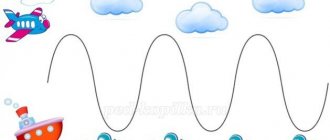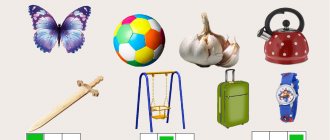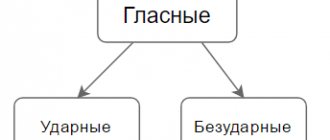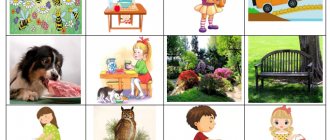LESSON SUMMARY FOR Speech Therapists
Welcome! Speech therapy site "Chatterbox" - a site for speech therapists and caring parents!Summary of a lesson on differentiating sounds [d] - [t] in syllables, words, sentences. author: Terentyeva Natalya Aleksandrovna, teacher-speech therapist MBOU secondary school No. 3 Yamalo-Nenets Autonomous Okrug, Salekhard date: 04/24/2012
target:
- clarification and comparison of articulation and sound of sounds [d] and [t];
tasks:
- teach children to differentiate sounds;
- enrich children's vocabulary;
- develop skills of syllabic analysis and synthesis;
- consolidate knowledge of language norms;
- promote the development of coherent speech, higher mental processes (development of voluntary attention, auditory memory, motor skills);
- learn to establish cause-and-effect relationships;
equipment:
- cards with articulation gymnastics;
- letters "d" and "t";
- subject pictures: melon, chair, pencil, house, plate, cabbage, bucket, slippers, bus, duck, fishing rod;
- cards with words: duck, fishing rod;
organizational moment
Whoever wants to talk must pronounce everything correctly and clearly, so that everyone can understand it. We will pronounce everything correctly and clearly, so that everyone can understand.
— In order to speak beautifully, we must do articulatory gymnastics.
articulatory gymnastics
Exercises: “Painter”, “Frog and Baby Elephant”, “Swing”. - Well done, you did a good job and your articulatory apparatus is ready for further work.
development of phonemic awareness
- Look at the object pictures and name them. (Duck, fishing rod). - How many sounds are in these words? (6 sounds). - These are very similar words to “duck-fishing rod”. - How do they differ? — In the word “fishing rod” the second sound is [d]. — In the word “duck” the second sound is [t].
The words “duck” and “fishing rod” are posted on the board.
- Look, they changed one letter, but the whole word has changed. - Today we will learn to distinguish between the sounds [d] and [t] and the letters “d” and “t”, so as not to confuse them in writing.
comparative characteristics of sounds
- Let's characterize our sounds.
- Say the sounds [d] and [t]. Is the position of the lips the same when pronouncing these sounds? (Equal).
- How do we pronounce these sounds? The lips are slightly parted, the tip of the tongue rests on the upper teeth, and the exhaled air “explodes” this barrier. Consonant sounds.
— Put your hand on the neck and listen, does the neck tremble when pronouncing the sound [d]? (Trembles). - Is this sound pronounced with or without a voice? (With voice).
- Now pronounce the sound [t] and listen, does your throat tremble when pronouncing this sound? (Doesn't shake). This means that the sound is pronounced without a voice.
- We can draw a conclusion. The sound [d] is pronounced with a voice, it is sonorous and is determined by the letter “d” in writing and when reading. And the sound [t] is pronounced without a voice, it is deaf and is determined by the letter “t” in writing and when reading.
[t] - consonant, deaf, pronounced without voice. [d] - consonant, voiced, voice is involved in pronunciation.
correlation of sound and letter
— Sounds in writing and when reading are indicated by what? (In letters). - Remember what letter elements we need to write lowercase letters and make up these letters. - Tell me, if you put a consonant and a vowel sound together, what do they form? (Syllable).
differentiation of sounds in syllables
- Look at the diagram, compose and read the syllables. - Write down the syllables in pairs according to voiced-voicelessness. (Write on the board). - Indicate in them the presence of sounds studied in class.
T\A O U/D
- TA, TO, TU; - YES, DO, DU;
- What is formed from syllables? (Words). - Open your notebooks, move 2 lines down and write down today’s date.
differentiation of sounds in words
— Now let’s play the game “What is where?” — We will write down the guessed word in a notebook and highlight the letters with which we are working today. Pictures: melon, chair, pencil, house, plate, cabbage, bucket, slippers, bus.
— What sound do we hear in the word “cabbage”? (In the word “cabbage” we hear the sound [t]. It is consonant, unvoiced. So, we draw a bell without a tongue. We write the letter “t”).
- What sound do we hear in the word “house”. (In the word “house” we hear the sound [d]. It is consonant, sonorous. So, we draw a bell with a tongue. We write the letter “d”).
The rest of the words are analyzed by analogy.
“The guys did a good job with this task.” — Tell me, what do words that are related to each other in meaning form? (Offers).
differentiation of sounds in a sentence
- Make sentences from these words and think about what kind of story can come out of these sentences.
U, house, in the village, grandfather. Pond, villages, approx. In the summer, Tyoma, was with his grandfather.
- Read what you got.
- Write down each of your sentences in a notebook and find our letters in it.
- Highlight our letters, as we did in words.
— Sentences related to each other in meaning form what? (Story).
- Let's try to put our sentences so that we get a story. (Grandfather has a house in the village. There is a pond near the village. In the summer, Tyoma was with grandfather.)
- Come up with a continuation of our story. (I option: He went fishing in the summer. There were a lot of fish in the pond. Tyoma likes to relax in the village in the summer. II option: Grandfather gave Tyoma a fishing rod. The boy went fishing every morning. He gave the fish to the cat Vaska. The boy loves fishing very much.)
- How can we title our text?
lesson summary
- What sounds did we learn to distinguish in our lesson? ([t], [d]). - Give a brief description of these sounds.
[t] - consonant, deaf, pronounced without voice. [d] - consonant, voiced, voice is involved in pronunciation.
- Why did we learn to distinguish these sounds? (To write without errors).
Article:
target:
- clarification and comparison of articulation and sound of sounds [d] and [t];
tasks:
- teach children to differentiate sounds;
- enrich children's vocabulary;
- develop skills of syllabic analysis and synthesis;
- consolidate knowledge of language norms;
- promote the development of coherent speech, higher mental processes (development of voluntary attention, auditory memory, motor skills);
- learn to establish cause-and-effect relationships;
equipment:
- cards with articulation gymnastics;
- letters "d" and "t";
- subject pictures: melon, chair, pencil, house, plate, cabbage, bucket, slippers, bus, duck, fishing rod;
- cards with words: duck, fishing rod;
Organizing time
Anyone who wants to talk must pronounce everything correctly and clearly, so that everyone can understand it. We will pronounce everything correctly and clearly, so that everyone can understand.
— In order to speak beautifully, we must do articulatory gymnastics.
articulatory gymnastics
Exercises: “Painter”, “Frog and Baby Elephant”, “Swing”. - Well done, you did a good job and your articulatory apparatus is ready for further work.
development of phonemic awareness
- Look at the object pictures and name them. (Duck, fishing rod). - How many sounds are in these words? (6 sounds). - These are very similar words to “duck-fishing rod”. - How do they differ? — In the word “fishing rod” the second sound is [d]. — In the word “duck” the second sound is [t].
The words “duck” and “fishing rod” are posted on the board.
- Look, they changed one letter, but the whole word has changed. - Today we will learn to distinguish between the sounds [d] and [t] and the letters “d” and “t”, so as not to confuse them in writing.
comparative characteristics of sounds
- Let's characterize our sounds.
- Say the sounds [d] and [t]. Is the position of the lips the same when pronouncing these sounds? (Equal).
- How do we pronounce these sounds? The lips are slightly parted, the tip of the tongue rests on the upper teeth, and the exhaled air “explodes” this barrier. Consonant sounds.
— Put your hand on the neck and listen, does the neck tremble when pronouncing the sound [d]? (Trembles). - Is this sound pronounced with or without a voice? (With voice).
- Now pronounce the sound [t] and listen, does your throat tremble when pronouncing this sound? (Doesn't shake). This means that the sound is pronounced without a voice.
- We can draw a conclusion. The sound [d] is pronounced with a voice, it is sonorous and is determined by the letter “d” in writing and when reading. And the sound [t] is pronounced without a voice, it is deaf and is determined by the letter “t” in writing and when reading.
[t] - consonant, deaf, pronounced without voice. [d] - consonant, voiced, voice is involved in pronunciation.
correlation of sound and letter
— Sounds in writing and when reading are indicated by what? (In letters). - Remember what letter elements we need to write lowercase letters and make up these letters. - Tell me, if you put a consonant and a vowel sound together, what do they form? (Syllable).
differentiation of sounds in syllables
- Look at the diagram, compose and read the syllables. - Write down the syllables in pairs according to voiced-voicelessness. (Write on the board). - Indicate in them the presence of sounds studied in class.
T \ A O U / D - TA, TO, TU; - YES, DO, DU;
- What is formed from syllables? (Words). - Open your notebooks, move 2 lines down and write down today’s date.
differentiation of sounds in words
— Now let’s play the game “What is where?” — We will write down the guessed word in a notebook and highlight the letters with which we are working today. Pictures: melon, chair, pencil, house, plate, cabbage, bucket, slippers, bus.
— What sound do we hear in the word “cabbage”? (In the word “cabbage” we hear the sound [t]. It is consonant, unvoiced. So, we draw a bell without a tongue. We write the letter “t”).
- What sound do we hear in the word “house”. (In the word “house” we hear the sound [d]. It is consonant, sonorous. So, we draw a bell with a tongue. We write the letter “d”).
The rest of the words are analyzed by analogy.
“The guys did a good job with this task.” — Tell me, what do words that are related to each other in meaning form? (Offers).
differentiation of sounds in a sentence
- Make sentences from these words and think about what kind of story can come out of these sentences.
U, house, in the village, grandfather. Pond, villages, approx. In the summer, Tyoma, was with his grandfather.
- Read what you got.
- Write down each of your sentences in a notebook and find our letters in it.
- Highlight our letters, as we did in words.
— Sentences related to each other in meaning form what? (Story).
- Let's try to put our sentences so that we get a story. (Grandfather has a house in the village. There is a pond near the village. In the summer, Tyoma was with grandfather.)
- Come up with a continuation of our story. (I option: He went fishing in the summer. There were a lot of fish in the pond. Tyoma likes to relax in the village in the summer. II option: Grandfather gave Tyoma a fishing rod. The boy went fishing every morning. He gave the fish to the cat Vaska. The boy loves fishing very much.)
- How can we title our text?
lesson summary
- What sounds did we learn to distinguish in our lesson? ([t], [d]). - Give a brief description of these sounds.
[t] - consonant, deaf, pronounced without voice. [d] - consonant, voiced, voice is involved in pronunciation.
- Why did we learn to distinguish these sounds? (To write without errors).



